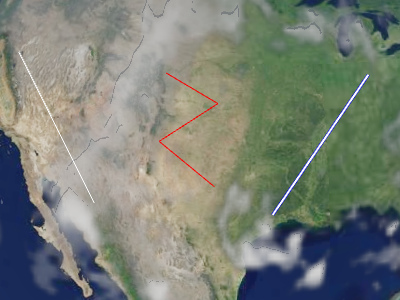new PolylineCollection(optionsopt)
A renderable collection of polylines.

Example polylines
Polylines are added and removed from the collection using

Example polylines
Polylines are added and removed from the collection using
PolylineCollection#add
and PolylineCollection#remove.
Parameters:
| Name | Type | Attributes | Description | |||||||||||||||
|---|---|---|---|---|---|---|---|---|---|---|---|---|---|---|---|---|---|---|
options |
Object |
<optional> |
Object with the following properties:
Properties
|
- Source:
- See:
Example
// Create a polyline collection with two polylines
var polylines = new Cesium.PolylineCollection();
polylines.add({
positions : Cesium.Cartesian3.fromDegreesArray([
-75.10, 39.57,
-77.02, 38.53,
-80.50, 35.14,
-80.12, 25.46]),
width : 2
});
polylines.add({
positions : Cesium.Cartesian3.fromDegreesArray([
-73.10, 37.57,
-75.02, 36.53,
-78.50, 33.14,
-78.12, 23.46]),
width : 4
});Members
debugShowBoundingVolume :Boolean
This property is for debugging only; it is not for production use nor is it optimized.
Draws the bounding sphere for each draw command in the primitive.
Type:
- Boolean
- Default Value:
- false
- Source:
length :Number
Returns the number of polylines in this collection. This is commonly used with
PolylineCollection#get to iterate over all the polylines
in the collection.
Type:
- Number
- Source:
modelMatrix :Matrix4
The 4x4 transformation matrix that transforms each polyline in this collection from model to world coordinates.
When this is the identity matrix, the polylines are drawn in world coordinates, i.e., Earth's WGS84 coordinates.
Local reference frames can be used by providing a different transformation matrix, like that returned
by
Transforms.eastNorthUpToFixedFrame.
Type:
- Default Value:
- Source:
Methods
add(polylineopt) → {Polyline}
Creates and adds a polyline with the specified initial properties to the collection.
The added polyline is returned so it can be modified or removed from the collection later.
Parameters:
| Name | Type | Attributes | Description |
|---|---|---|---|
polyline |
Object |
<optional> |
A template describing the polyline's properties as shown in Example 1. |
- Source:
- See:
Throws:
-
This object was destroyed, i.e., destroy() was called.
- Type
- DeveloperError
Returns:
The polyline that was added to the collection.
- Type
- Polyline
Example
// Example 1: Add a polyline, specifying all the default values.
var p = polylines.add({
show : true,
positions : ellipsoid.cartographicArrayToCartesianArray([
Cesium.Cartographic.fromDegrees(-75.10, 39.57),
Cesium.Cartographic.fromDegrees(-77.02, 38.53)]),
width : 1
});contains(polyline) → {Boolean}
Determines if this collection contains the specified polyline.
Parameters:
| Name | Type | Description |
|---|---|---|
polyline |
Polyline | The polyline to check for. |
- Source:
- See:
Returns:
true if this collection contains the polyline, false otherwise.
- Type
- Boolean
destroy() → {undefined}
Destroys the WebGL resources held by this object. Destroying an object allows for deterministic
release of WebGL resources, instead of relying on the garbage collector to destroy this object.
Once an object is destroyed, it should not be used; calling any function other than
Once an object is destroyed, it should not be used; calling any function other than
isDestroyed will result in a DeveloperError exception. Therefore,
assign the return value (undefined) to the object as done in the example.
Throws:
-
This object was destroyed, i.e., destroy() was called.
- Type
- DeveloperError
Returns:
- Type
- undefined
Example
polylines = polylines && polylines.destroy();get(index) → {Polyline}
Returns the polyline in the collection at the specified index. Indices are zero-based
and increase as polylines are added. Removing a polyline shifts all polylines after
it to the left, changing their indices. This function is commonly used with
PolylineCollection#length to iterate over all the polylines
in the collection.
Parameters:
| Name | Type | Description |
|---|---|---|
index |
Number | The zero-based index of the polyline. |
- Source:
- See:
Throws:
-
This object was destroyed, i.e., destroy() was called.
- Type
- DeveloperError
Returns:
The polyline at the specified index.
- Type
- Polyline
Example
// Toggle the show property of every polyline in the collection
var len = polylines.length;
for (var i = 0; i < len; ++i) {
var p = polylines.get(i);
p.show = !p.show;
}isDestroyed() → {Boolean}
Returns true if this object was destroyed; otherwise, false.
If this object was destroyed, it should not be used; calling any function other than
If this object was destroyed, it should not be used; calling any function other than
isDestroyed will result in a DeveloperError exception.
- Source:
- See:
Returns:
true if this object was destroyed; otherwise, false.
- Type
- Boolean
remove(polyline) → {Boolean}
Removes a polyline from the collection.
Parameters:
| Name | Type | Description |
|---|---|---|
polyline |
Polyline | The polyline to remove. |
- Source:
- See:
Throws:
-
This object was destroyed, i.e., destroy() was called.
- Type
- DeveloperError
Returns:
true if the polyline was removed; false if the polyline was not found in the collection.
- Type
- Boolean
Example
var p = polylines.add(...);
polylines.remove(p); // Returns trueremoveAll()
Removes all polylines from the collection.
- Source:
- See:
Throws:
-
This object was destroyed, i.e., destroy() was called.
- Type
- DeveloperError
Example
polylines.add(...);
polylines.add(...);
polylines.removeAll();update()
Called when
Viewer or CesiumWidget render the scene to
get the draw commands needed to render this primitive.
Do not call this function directly. This is documented just to list the exceptions that may be propagated when the scene is rendered:
- Source:
Throws:
-
Vertex texture fetch support is required to render primitives with per-instance attributes. The maximum number of vertex texture image units must be greater than zero.
- Type
- RuntimeError